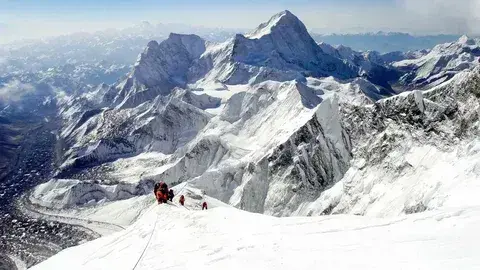If you’ve ever wondered about the mysterious side of Mount Everest, then you’ve probably come across the tragic tale of “Everest Sleeping Beauty.” It’s one of the most haunting reminders of the harsh, unforgiving reality that climbers face on the world’s tallest peak.
And here’s the kicker: despite the fame and glory attached to climbing Everest, over 300 people have died on its slopes, many of whom remain there, frozen in time. Their bodies become waypoints, even warnings for future climbers. And no story captures this eerie truth more poignantly than Everest Sleeping Beauty’s.
But what makes this particular tale so captivating? Why does it stick with you, long after you’ve heard it? Let’s get into the real story behind the name, the challenges that climbers face at those altitudes, and why, even for the most experienced, Everest remains one of the most dangerous places on earth.
Who Was Everest Sleeping Beauty?
“Everest Sleeping Beauty” refers to the frozen body of climber Francys Arsentiev, an American who attempted to reach the summit without supplemental oxygen in 1998. The term “Sleeping Beauty” arose because of how her body appeared at the time of her passing—peaceful, almost as if she were simply asleep, despite the brutal environment around her.
Francys was no amateur. She’d trained for years, climbed multiple peaks, and understood the risks. But Everest has a way of bringing even the most experienced climbers to their knees. Without supplemental oxygen, the climb becomes intensely grueling, pushing the human body to its absolute limits.
Tragically, Francys and her husband Sergei attempted the summit multiple times, fighting through exhaustion, extreme cold, and the relentless altitude. They finally made it but paid the ultimate price. Her body was found near the summit, and climbers who passed her assumed she was resting until they realized the truth.
The Dangers of Climbing Everest
You may wonder why anyone would attempt such a dangerous feat, but for many, Everest represents the ultimate challenge—a shot at immortality.
Yet the risks are severe:
- Altitude Sickness: Above 26,000 feet lies the “death zone,” where oxygen levels are insufficient to sustain human life. Without acclimatization, you face dizziness, hallucinations, even death.
- Extreme Temperatures: Temperatures drop to minus 30°F, even lower at times, freezing any exposed skin within minutes.
- Unpredictable Weather: Weather can change in an instant. You may start your summit attempt with clear skies and end in a blizzard, completely disoriented.
- Exhaustion: At that altitude, even simple tasks feel impossible. Taking a single step can feel like running a marathon, and every ounce of energy counts.
Everest isn’t just a mountain; it’s a force of nature. It doesn’t care about ambition, experience, or ego, and for climbers, this is both thrilling and terrifying.
Why Do Bodies Remain on Everest?
One of the most haunting realities of Everest is the sheer number of bodies that remain there, marking different routes.
Moving a body at such an altitude is nearly impossible due to:
- Weight and Terrain: In the thin air, moving anything heavy becomes an ordeal. The frozen ground and steep slopes make it a logistical nightmare.
- Danger to Rescuers: Carrying a body could endanger the lives of others. Even experienced climbers can lose their lives attempting to retrieve those who didn’t make it.
It’s not that climbers don’t care—it’s just that Everest requires brutal practicality. In many cases, the climbers who died were experienced individuals, aware of the risks, and even requested not to be retrieved if they were to perish.
For Francys Arsentiev, her death on the mountain has become a stark reminder of the potential price of seeking glory in one of Earth’s most unforgiving environments.
The Legacy of Everest Sleeping Beauty
Francys’s body lay visible for years, haunting climbers who passed by. Her husband, Sergei, attempted to save her, but he tragically lost his life as well. Their story became a symbol, a warning, and a legend that lives on in Everest’s infamous death zone.
Eventually, other climbers moved her body out of sight to show respect and prevent it from being a disturbing sight for others attempting the climb. But her memory lingers, embedded in Everest’s story.
Her tale illustrates something profound: climbing Everest is not just about reaching the summit; it’s about survival. For those who attempt it, there’s no certainty they’ll return. Francys Arsentiev, the Everest Sleeping Beauty, represents the many dreams and lives that Everest has claimed.
Why People Still Attempt Everest Despite the Risks
Climbing Everest isn’t just a sport or a hobby; for many, it’s a calling. It’s an obsession fueled by:
- Personal Challenge: Many climbers want to push their limits, to face the ultimate physical and mental test.
- Recognition and Glory: Standing at the top of the world comes with a sense of achievement that few experiences can match.
- Legacy: Everest climbers know the risks but are driven by the idea of leaving a legacy.
For some, the possibility of “not making it” is a risk they’re willing to take for a shot at greatness. This mindset is hard for outsiders to understand, yet it’s what drives climbers to train for years, spend thousands, and put themselves in life-or-death situations.
FAQs About Everest and the Story of Sleeping Beauty
1. Why is she called Everest Sleeping Beauty?
The term “Sleeping Beauty” was used because Francys Arsentiev appeared to be peacefully sleeping when she passed, despite the harsh conditions.
2. How many bodies are on Everest?
There are over 200 bodies scattered across Everest. Some become markers on the trail, silently warning climbers of the mountain’s dangers.
3. Is climbing Everest getting safer?
While advancements in equipment and weather tracking have improved safety, the risks remain. Altitude sickness, extreme weather, and exhaustion still claim lives every season.
4. Why do climbers leave bodies on Everest?
Recovering a body from Everest’s death zone is incredibly dangerous, expensive, and physically exhausting. Often, it’s just not feasible.
5. How does Francys Arsentiev’s story impact climbers today?
Francys’s story serves as a reminder of Everest’s brutal reality. It teaches climbers the importance of preparation, respect for the mountain, and the real dangers of attempting the summit.
Final Thoughts on the Legacy of Everest Sleeping Beauty
Francys Arsentiev’s story as Everest Sleeping Beauty resonates because it combines adventure with tragedy, ambition with loss.
She’s a symbol, a reminder of Everest’s beauty and brutality, forever part of the mountain’s legend.
Everest will always attract those who seek to conquer it, and her story serves as a solemn reminder of the risks.
For many, that’s part of the allure. The mountain holds beauty and danger in equal measure.
And perhaps that’s why, despite everything, climbers keep coming back.
Read More: SkinCareSensation

